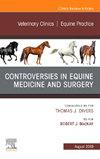Plants that Contaminate Feed and Forage and Poison Horses: Equine Ttxicology.
IF 1.1
3区 农林科学
Q3 VETERINARY SCIENCES
Veterinary Clinics of North America-Equine Practice
Pub Date : 2023-12-06
DOI:10.1016/j.cveq.2023.11.003
引用次数: 0
Abstract
Many toxic plants are unpalatable to horses and are not eaten when alternative forage is available. However, when such plants contaminate prepared or baled feed and forage, herd competition and improved palatability can alter acceptance and thereby cause equine plant poisonings. Dehydropyrrolizidine alkaloid-containing plants; cocklebur; Salvia reflexa; kleingrass, switchgrass, and other saponin-containing grasses; jimson weed, black henbane, and other tropane alkaloid-containing plants; lantana; Cassia spp and other myotoxic plants; castor bean; cyanogenic glycoside-containing plants; thiaminase-containing plants; and hoary alyssum are among those that most commonly poison horses in North America via contaminated feed or forage.
污染饲料和饲草并毒害马匹的植物:马毒物学
许多有毒植物对马来说并不可口,如果有替代饲料,马就不会食用。但是,当这些植物污染了准备好或打包好的饲料和饲草时,马群的竞争和适口性的提高会改变马匹的接受程度,从而导致马匹植物中毒。含脱氢吡咯烷生物碱的植物;鸡冠花;丹参;克利草、开关草和其他含皂甙的草;姬松草、黑鸡血藤和其他含托烷生物碱的植物;香蒲;决明子属和其他肌毒性植物、蓖麻、含氰苷的植物、含硫胺素酶的植物和蹄甲草是北美洲最常见的通过污染饲料或饲草毒害马匹的植物。
本文章由计算机程序翻译,如有差异,请以英文原文为准。
求助全文
约1分钟内获得全文
求助全文
来源期刊
CiteScore
2.10
自引率
9.10%
发文量
55
审稿时长
>36 weeks
期刊介绍:
Veterinary Clinics of North America: Equine Practice presents those in the veterinary medicine field with the most current treatment of horses, updates on the latest advances, and provides a sound basis for choosing treatment options. Published 3 times a year—in April, August, and December—each issue features expert, state-of-the-art reviews on a single topic in equine practice, including gastroenterology, imaging, infectious diseases, nutrition, orthopedics, pathology, pharmacology and therapeutics, and surgery.

 求助内容:
求助内容: 应助结果提醒方式:
应助结果提醒方式:


